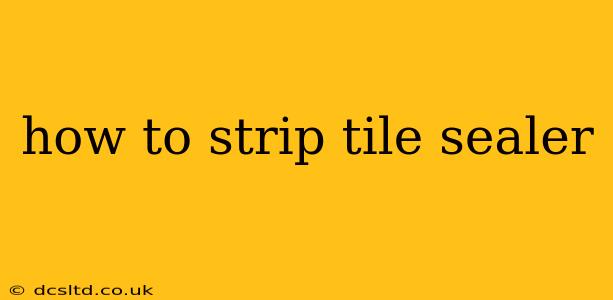Tile sealer, while protecting your beautiful tile surfaces from stains and damage, can eventually wear down, requiring removal and reapplication for optimal protection. Stripping tile sealer might seem daunting, but with the right approach and tools, it's a manageable DIY project. This guide will walk you through the process, addressing common questions and concerns.
Why Strip Tile Sealer?
Before diving into the how, let's understand the why. Several reasons necessitate stripping tile sealer:
- Loss of Effectiveness: Over time, sealer wears away due to foot traffic, cleaning agents, and general wear and tear. This reduces its protective capabilities, leaving your tiles vulnerable to staining.
- Yellowing or Discoloration: Some sealers can yellow or discolor over time, affecting the aesthetic appeal of your tile. Stripping allows for a fresh, clean start.
- Reapplication: Proper sealer application often requires a clean, sealer-free surface. Stripping is crucial before applying a new coat.
- Poor Initial Application: If the initial application was flawed, stripping and reapplying ensures proper protection.
What Tools and Materials Will I Need?
Gathering the right tools and materials is crucial for a successful tile sealer stripping project. You'll need:
- Tile Sealer Remover: Choose a remover specifically designed for the type of sealer you have (e.g., penetrating sealer, topical sealer). Follow the manufacturer's instructions carefully.
- Stiff-Bristled Brush: A durable brush is essential for scrubbing the remover into the grout and tile.
- Scrub Pad or Sponge: Use a non-abrasive scrub pad or sponge for delicate tiles.
- Bucket: To hold the cleaning solution.
- Clean Cloths or Rags: For wiping away the remover and rinsing.
- Vacuum or Shop-Vac: To remove excess debris and cleaning solution.
- Protective Gear: Wear gloves, eye protection, and a mask to prevent exposure to harsh chemicals.
- pH-Neutral Cleaner: For a final rinse to remove any residual remover.
How to Choose the Right Tile Sealer Remover?
Selecting the right tile sealer remover is critical. Different sealers require different removers. Read the label of your existing sealer carefully – it may have recommendations for removal. If you're unsure, contact the manufacturer or a tile professional for guidance.
What are the different types of tile sealers?
There are primarily two types: penetrating sealers and topical sealers. Penetrating sealers soak into the tile, while topical sealers sit on the surface. The type of sealer dictates the removal method. Consult the product label for specific removal instructions.
Step-by-Step Guide to Stripping Tile Sealer
- Preparation: Thoroughly clean the tile surface to remove any loose dirt, debris, or existing cleaning solutions. Vacuum or sweep the area.
- Apply the Sealer Remover: Follow the manufacturer's instructions carefully. Usually, it involves applying the remover liberally to the tile surface and allowing it to dwell for the recommended time.
- Scrubbing: Use a stiff-bristled brush or scrub pad to work the remover into the grout and tile, gently agitating the sealer. Avoid excessive scrubbing, which could damage the tile surface.
- Rinse Thoroughly: Rinse the surface with plenty of clean water to remove all traces of the remover. Use a wet/dry vacuum if possible to suck up excess water and sealer residue.
- Neutralize: Use a pH-neutral cleaner to remove any residual traces of the sealer remover and ensure a clean surface for re-sealing.
- Dry Completely: Allow the tile to dry completely before applying a new sealer. This could take several hours or even overnight, depending on ventilation and humidity.
How Long Does It Take to Strip Tile Sealer?
The time required to strip tile sealer varies significantly based on the type and amount of sealer, the size of the area, and the chosen method. Expect to allocate at least several hours for a small area, potentially extending to a full day for larger projects.
Can I Strip Tile Sealer Myself, or Should I Hire a Professional?
While stripping tile sealer is a DIY-able task, hiring a professional may be a better option if you're dealing with a large area, intricate tile patterns, or have limited experience with such projects. Professionals possess the expertise and tools to efficiently and effectively remove the sealer without damaging the tile.
Important Safety Precautions
- Ventilation: Ensure good ventilation while working with chemical removers. Open windows and doors, or use a fan.
- Protective Gear: Always wear gloves, eye protection, and a mask.
- Test in an Inconspicuous Area: Before applying the remover to the entire surface, test it in a small, inconspicuous area to check for any adverse reactions.
By following these steps and safety precautions, you can successfully strip your tile sealer and prepare the surface for a fresh, protective coat. Remember, patience and meticulous work are key to achieving the best results.
